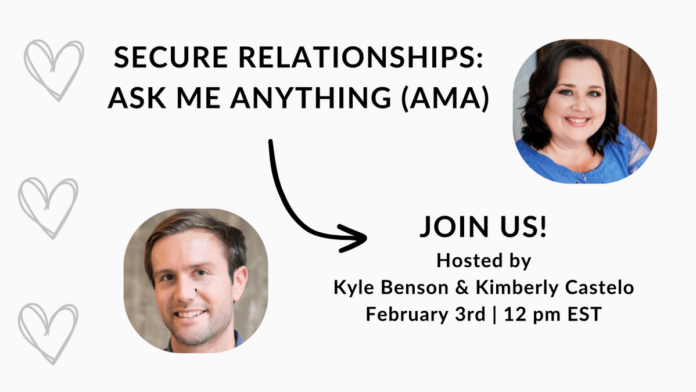[ad_1]

In a recent interactive session on Facebook, Kimberly Castelo, a Certified Emotionally Focused Couples Therapist, and I embarked on an Ask Me Anything (AMA) focused on Secure Relationships. Due to unforeseen technical hiccups, we transitioned to Zoom, which, unfortunately, led to the inability to record our session or directly address all the questions submitted. Recognizing the importance of supporting our audience, we’ve compiled this written response to cover the key themes and questions you shared.
Please note: The insights shared here are intended purely for educational purposes and are not a substitute for professional therapy. They aim to offer guidance based on our expertise in Emotionally Focused Therapy (EFT). Still, they cannot replace the personalized support therapy provides as your therapist will have more context and understanding of your lived experiences.
We wanted to address some of the themes in the submitted questions since we couldn’t record the AMA.
The Challenge: You experience your partner emotionally shutting down in reaction to stress, leaving you feeling unsupported, particularly during critical times. You yearn to have your partner be there for you in these difficult times but question whether you should turn to friends for emotional support than your partner.
Kim and Kyle’s Thoughts: In our experience as Emotionally Focused Couples Therapists, which is effective in reducing avoidance and anxiety-related attachment fears, it’s essential to externalize the overall pattern that creates the shutting down and emotional loneliness. In such situations, the partner withdrawing often shuts down as a self-protective measure or discomfort with fearing they won’t say the right thing, so they choose silence rather than “making things worse,” not realizing the impact of the loneliness of their partner.
This touches on the intent vs. impact dynamic. The distancing partner is trying to keep things calm and stable without making things worse, and the pursuing partner is left feeling isolated and wanting to connect. This can lead to the pursuing partner armoring up emotionally and getting pokey which reinforces the distancer’s belief that the best move is not to make things worse.
It’s also important to better understand your attachment style as well as your partners. Withdrawing partners struggle to show up emotionally because they are afraid of getting it wrong. Showing up for others emotionally is not how many were taught to comfort another person, so they often use their head and logic. This is because they did not receive that emotional comfort when they grew up. Staying in their head and using logic keeps them safe from getting it wrong.
Even though they are trying to meet their partner’s needs logically, they are missing their partner’s heart, which needs emotional connection. When the emotional needs are unmet, the pursuing partner is usually left wondering if they matter. They might shut down and not share emotionally in the future or get more pokey which in turn makes the other partner withdraw more! In our work, both partners want a safe and secure connection but struggle with knowing how to create that since that was never modeled or experienced prior.
Understanding the negative cycle that keeps you stuck is crucial. Then, you can work together to create security, comfort, and connection. Regarding seeking out friendships as a form of comfort, it is helpful to utilize friendships during hard times for comfort in addition to your partner. In times of need, seek out both and continue to work with your partner to do things differently together. We recommend working with an emotionally focused couples therapist to help effectively change this dynamic.
So, the first thing is understanding the negative cycle and mapping out each other’s protective moves. You can learn more about how to do that here.
Finally, a concept from Emotionally Focused Therapy (EFT) is the “softening” conversation, where you express your vulnerability and the need for comfort behind your requests for support. Here’s what this can look like today, “I’m still struggling with the loss of my mother. Can you sit with me as we talk about memories and hold me while I grieve?” If your partner does this with you, work to make space for his effort to be there for you emotionally so you can take in this comfort.
Additional Resources:

The Challenge: You experience reluctance from your spouse to engage in personal growth. The history of betrayal, neurodiversity (ADHD), and childhood trauma creates a complex relational dynamic. It’s challenging when one partner is keen on growth, and the other appears resistant or fearful.
Kim and Kyle’s Thoughts: What we are reading with this question is that there is a lot of pain in this complex relational dynamic. Makes sense! It would be important to map the cycle the two of you get into. It is not uncommon for one partner to say that their partner does not want to grow, but if you ask the other partner, they would say they are actively working on being a better person!
It might feel frustrating to even think of your partner answering this way. What could happen is that you are speaking different languages per se and missing each other. The goal would be for you both to understand each other more.
- How do you need your partner to show up for growth – what would that look like to you?
- How is your partner trying to show up to grow – how can you make space for that try?
Individual therapy for both partners, in this case, can be beneficial. It can provide support and strategies to cope with the real feelings around the betrayal. For your partner, therapy focused on ADHD and trauma can be the first step toward healing and how to create a secure attachment style for themselves and you. Couples therapy can be helpful in providing a structured approach to improving communication, repairing attachment injuries such as betrayal, and understanding each other’s attachment needs.
EFT is particularly effective in creating healing relationships for couples dealing with trauma, incorporating the steps of conventional EFT and stages of trauma treatment to address not only relationship distress and attachment injuries but also individual symptoms of trauma-related disorders like PTSD, which is common after a betrayal.
Additional Resources:

The Challenge: You describe your marriage as emotionally volatile with clashes in personalities, and a self-protective wall indicates a deeply ingrained pattern of interaction, likely rooted in both partners’ attachment protection and past traumas.
Kim and Kyle’s Thoughts: Feeling like your relationship is all over the place emotionally can be tiring and also does not provide a space for you to build a sense of security. One of the goals would be to have couples counseling help slow down your interactions, understand why you do what you do (for each partner), and to name what is needed to feel safe, secure, and calm in the relationship. Trauma and attachment protection can cause a sense of vigilance in a relationship, not necessarily a feeling of calmness or rest. Couples therapy can help build that safe space for you to connect, rest, and find healing with each other.
It’s also important that you explore your role in the negative pattern. What we see in our work is partners are often not resisting changing the relationship; they are resisting how bad all it makes them feel. You can’t change your partner, but you can create a secure attachment environment by communicating in new ways and interrupting the cycle. You can model healthy changes rather than prescribing. You can share your concerns from an “I” stance and offer what you need in an actionable framework.
Emotionally Focused Therapy (EFT) can be particularly effective in such cases, helping both partners understand their attachment styles, how these play out in their interactions, and how to break the cycle of blame and defensiveness to create a more secure bond.

The Challenge: The fear that your partner may choose someone else over you and the resulting anxious attachment behaviors in your relationship make sense. Your efforts to maintain the relationship seem to be met with more anxiety and obsessive thoughts on how to deepen the connection.
Kim and Kyle’s Thoughts: It makes sense to be afraid of losing your partner. It is not uncommon to have people feel they are not enough for their partner. To avoid these feelings, we do a bunch of behaviors to calm that fear in us. Some of them might help, and some of them might push our partner farther away. There are two paths we see to changing this:
The first path is to share your fears of feeling insufficient and that you need reassurance about why your partner chooses you. If your partner offers that reassurance, make space to take that in. Fight to let their words be louder internally than the fear. You can also share that you struggle with this, and that their reassurance does wonders. And you might need that reassurance again in the future. Being direct about your fears and getting reassurance while also receiving the reassurance builds a more secure attachment.
The second path is when you spend time with them, focus on how good that feels, not how it needs to be “more” or “better.” If you can make space to savor the connection you’re currently getting when the two of you are focused on each other, it will allow the fear of it not being enough to be quieter. This fear of it not being enough is an unconscious anxious attachment strategy to maximize connection and continue to get more and more as a strategy to feel secure and safe. The problem is when we push for more, we miss out on what is right there and then both partners end up getting hurt.
I would also recommend both of you read the book Secure Love to continue to work on this.

The Challenge: Infidelity significantly impacts trust and security in a relationship, especially for someone with abandonment issues or an anxious attachment style. You feel that your emotional wounds are overlooked and neglected
Kim and Kyle’s Thoughts: We understand that following the discovery of infidelity, you can feel wounded and that wound feels like it doesn’t matter to your partner. Typically, we observe two prevalent reactions in such situations:
1. The partner is unwilling to acknowledge and soothe the wound.
2. Consumed by shame, the partner may defensively downplay the wound when the topic arises, as the intense shame hampers the healing process. “I’m a monster for hurting my partner and can’t sit with them in their pain.” In our experience, the latter is true for 98% of the couples we assist. For healing to commence, it’s crucial to diminish the impact of shame, allowing space for your pain to be connected with and for trust to be gradually restored.
To summarize, healing is indeed attainable, even amidst anxious attachment and fears of abandonment, provided shame is addressed, paving the way for comfort, reassurance, and care. As shame gets smaller, you’ll also have to work to lean into accepting the comfort so trust can be built.
It’s worth noting that healed wounds might occasionally be inadvertently aggravated (similar to a rug burn). However, with the proper approach and understanding, such instances can also contribute to the healing journey and security of the relationship.
We strongly recommend consulting an emotionally focused couples therapist. Professional guidance can help in reducing the influence of shame and support both of you in the process of rebuilding trust.
If you want to gain more thoughts from Kim and I, please join us for our next AMA below.
March 9, 2024: AMA on Secure Relationships

Two steps to take to get the most out of the next AMA.
- Click here to register for the event.
- Submit your relationship questions here.
Related
[ad_2]
www.kylebenson.net







